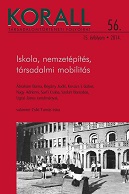Reprodukció és mobilitás. A középfokú oktatás társadalmi funkciói a dualizmusban
Reproduction and Mobility. The Social Functions of Secondary Education in the Age of Dualism
Author(s): Csaba SasfiSubject(s): History
Published by: KORALL Társadalomtörténeti Egyesület
Summary/Abstract: Similarly to developed European countries, secondary education in Hungary comprised a unique institutional framework in the nineteenth century. The core of this framework was the traditional secondary school with a curriculum based on Latin and classical education, and the primary aim of preparing students for higher education. Besides this type of secondary school, modern types emerged from the middle of the nineteenth century onwards, such as Realschul, lower secondary schools, vocational teacher training schools and schools of trade and commerce. These took over part of the remit of traditional secondary schools and fundamentally diversified the institutional framework hitherto dominated by the traditional secondary schools, boarding schools and lyceums. The differentiation in this field naturally brought about a more varied distribution of students across the widening range of available secondary education institutions. The first half of the study explores the social characteristics of the distribution of students using data available about occupation, demographic and education in the 1910 Census. This analysis suggests that although traditional secondary schools remain prevalent in the first decade of the twentieth century, the more modern options for secondary education also developed into real alternatives on the educational landscape. Although students who wished to emulate their fathers’ high degree of education still typically chose traditional secondary schools, they ceased to form the absolute majority. The study suggests that the institutional modernisation process of secondary education did not result in social isolation and exclusivity for the more traditional types of secondary schools. The second half of the essay is a dynamic study of the student body of traditional secondary schools between 1882 and 1910, which not only confirms but also complements the findings discussed previously: while the students of this school type became more diverse as the schools became accessible for emerging modern-age social groups, the proportion of students from educated families somewhat decreased. At the same time, the largest subset of the student body in 1910 is still made up of of students from educated families, which lent a unique comprehensive character to the social profile of traditional secondary schools in this era. This character is best interpreted in the context of the influence of all available types of secondary education at the time, and the findings not only provide insight into social history, but also important lessons for the education policy makers of today.
Journal: Korall - Társadalomtörténeti folyóirat
- Issue Year: 2014
- Issue No: 56
- Page Range: 96-117
- Page Count: 22
- Language: Hungarian

